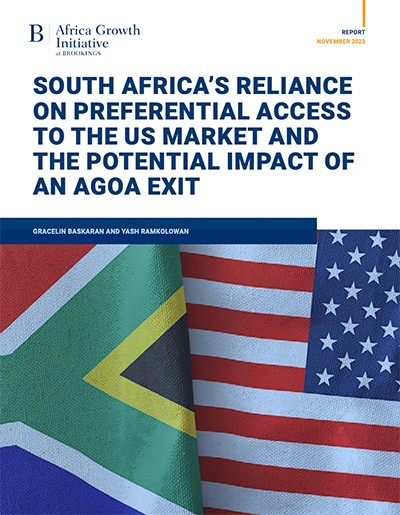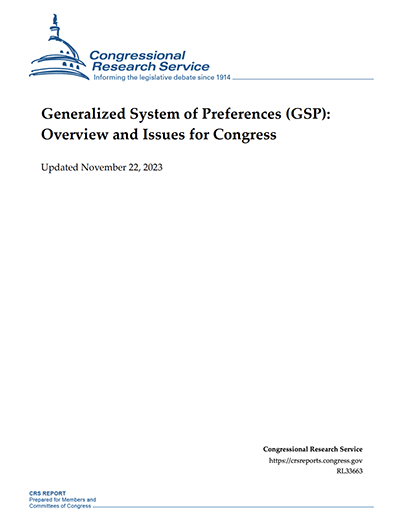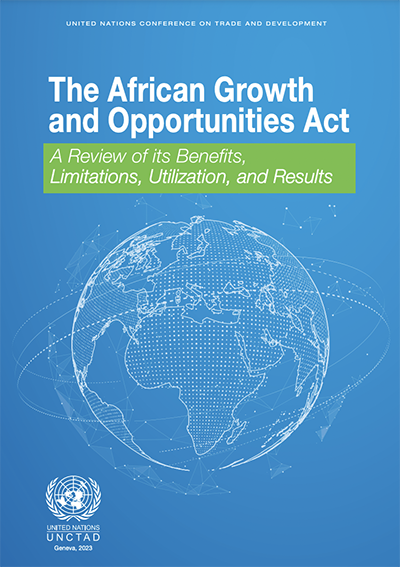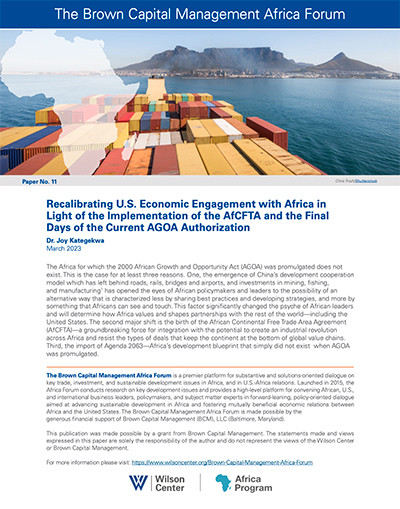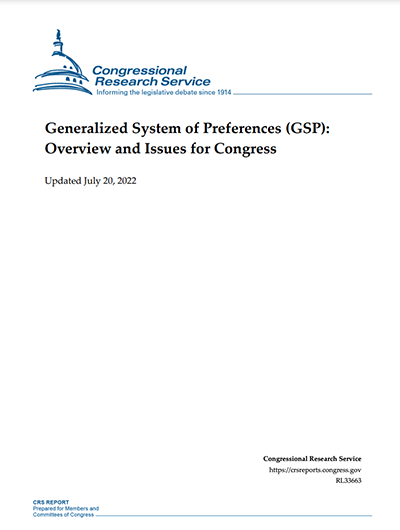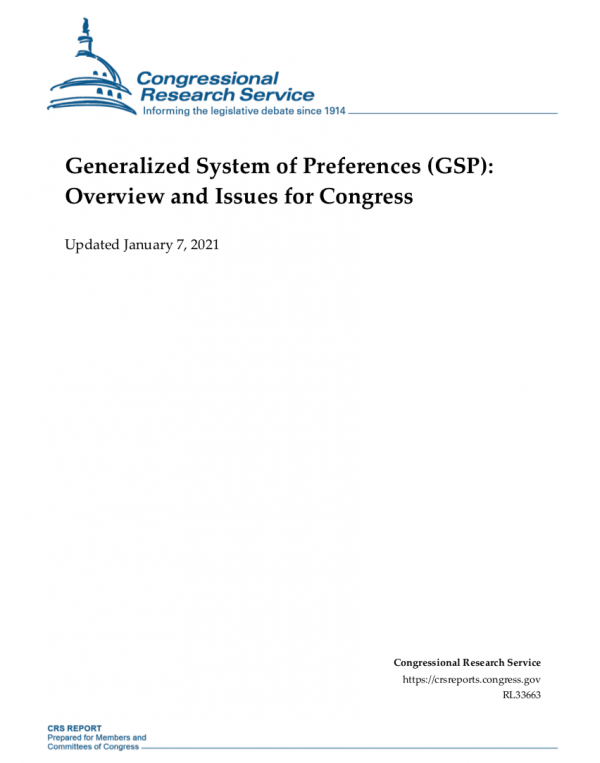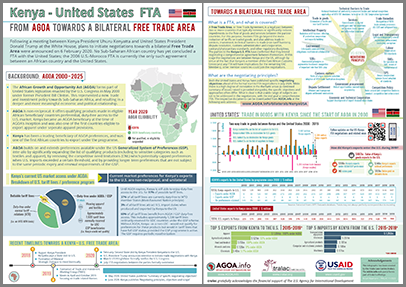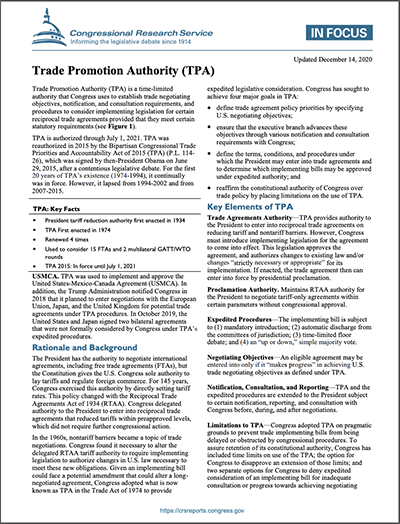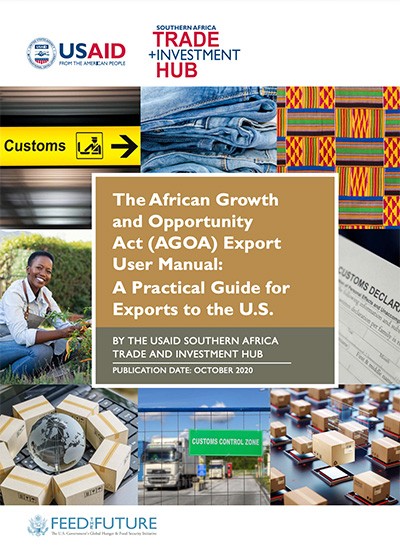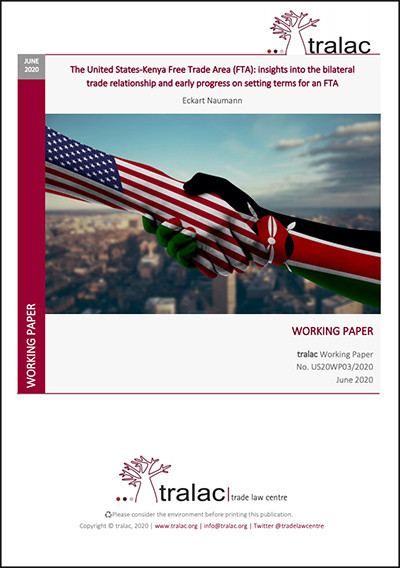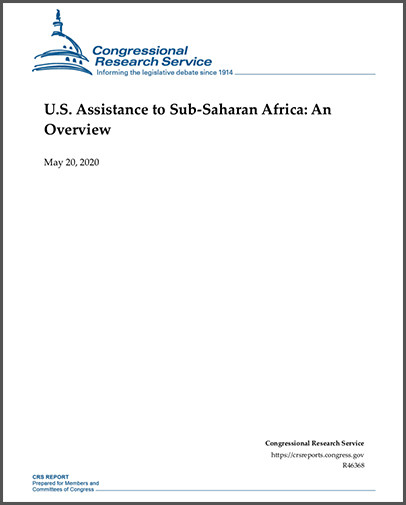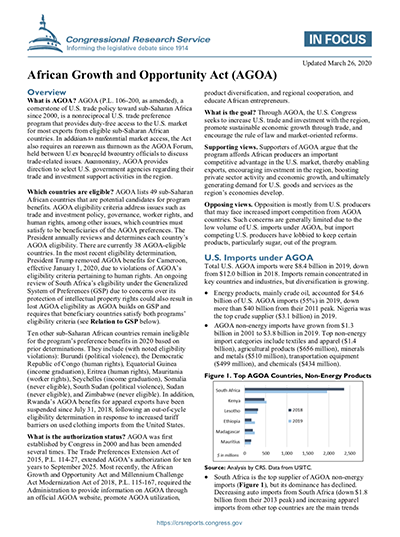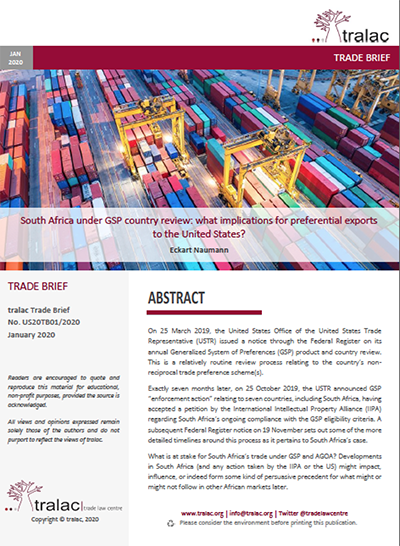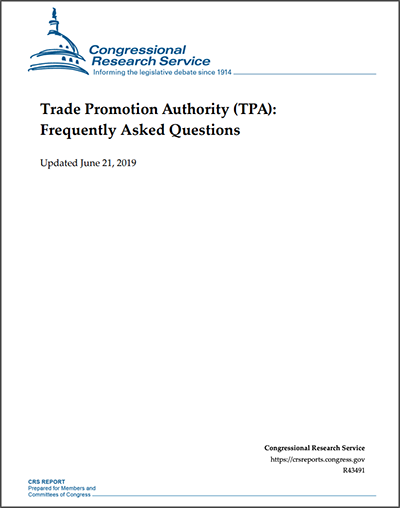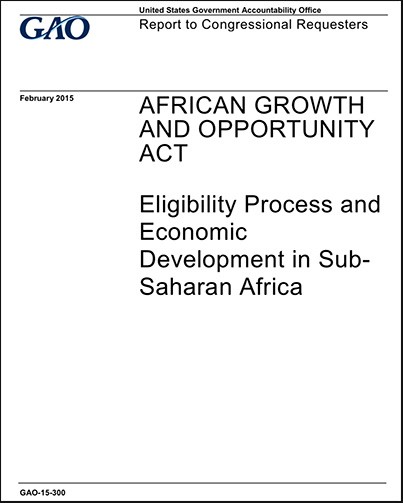Research Documents
South Africa’s reliance on preferential access to the US market and the potential impact of an AGOA exit
This paper has three objectives. First, it undertakes a brief review of the preferential access granted to South Africa by the U.S. through AGOA and the Generalized System of Preferences (GSP), which is the largest and oldest U.S. trade program. Second, a computable general equilibrium (CGE) model is utilized to assess the economic impact that a loss of AGOA and GSP preferences. Third, the paper provides an overview of the various broader implications of an AGOA suspension for South Africa, beyond the direct trade impacts.
Proposal on an early AGOA renewal alongside options to enhance the legislation and broaden its future impact
Proposal on an early AGOA renewal alongside several options to enhance the legislation and broaden its future impact.
Generalized System of Preferences (GSP): Overview and issues for Congress (November 2023 update)
This report examines, first, recent legislative developments, along with a brief history, economic rationale, and legal background leading to the establishment of GSP. Second, the report describes U.S. GSP implementation. Third, the report briefly analyzes the U.S. program’s effectiveness and stakeholders’ views, and discusses possible options for Congress.
Recent debates around South Africa's future AGOA eligibility and the potential impact on trade
This Trade Brief addresses recent developments and debates around AGOA, given lingering questions about South Africa’s future AGOA eligibility, and the potential impact on trade should AGOA preferences be lost. AGOA forms part of United States legislation and significantly opens the domestic market to qualifying exports from eligible Sub-Saharan beneficiary countries, removing import duties and having a created longer time horizons for such preferences. While these preferences are non-reciprocal, and have been extended to South Africa along with dozens of other Sub-Saharan developing and least-developed countries, they are not unconditional, and remain subject to the ongoing compliance and continuous assessment with the Act’s eligibility criteria. This Trade Brief highlights recent events insofar as they could possibly impact on South Africa’s future AGOA eligibility, and looks at some of the potential impacts on trade flows resulting from a loss of AGOA privileges. This more nuanced analysis considers existing sectoral trade, AGOA preference margins and current value chain realities, as well as the potential fall back of reverting to GSP access should this become a relevant option.
AGOA - A review of its benefits, limitations, utilization and results
This study on the African Growth and Opportunities Act was commissioned in 2022 by the United Nations Conference on Trade and Development. The four analytical sections that comprise this submission assess the AGOA program in progressively more specific levels. Section II addresses the overall relationship between poverty, trade preferences, and other instruments intended to promote economic development. The positive but limited impact of preferences can be seen in the utilization of the AGOA preferences, as reviewed in Section III. There differing experiences according to country and sector are assessed. The sectoral differences are examined more precisely in the next two sections, each of which address the United States International Trade Commission (USITC)’s stated intention to present case studies on cotton, apparel, certain chemicals, and cocoa. In Section IV the broader trends in United States imports of apparel, minerals, and other products from the region are reviewed. Section V turns to the question of whether AGOA preferences have helped beneficiary countries to upgrade their production and exports in hydrocarbons, cocoa, and cotton goods. Section VI concludes by providing specific considerations for the improvement of AGOA.
Uncertainty in preferential trade agreements: Impact of AGOA suspensions on exports
This study examines the impact of the abrupt suspension of African Growth and Opportunity Act benefits on exports from eligible African countries. The study uses a triple difference-in-differences estimation that controls for both country- and product-level export changes. The results suggest that the suspension of the African Growth and Opportunity Act has had a considerable negative impact on the level of exports to the United States. The impact appears to be bigger for countries with a high African Growth and Opportunity Act utilization rate. The suspen- sion is associated with a 39 percent decline in exports to the United States. At the product level, the suspension hurt apparel and textile exports, leading to a decline of their exports by about 88 percent. Understanding the impact of withdrawing access to a nonreciprocal trade agreement is particularly important now, as the European Union began negotiating Economic Partnership Agreements with Afri- can countries, as a sign of a shift to reciprocity; the United States is considering a similar path of negotiating free trade agreements with individual African countries. These devel- opments underscore the need to prepare for a post–African Growth and Opportunity Act period with more reciprocity, as trade uncertainty is becoming rampant.
Recalibrating US economic engagement with Africa in light of the implementation of the AfCFTA and the final days of the current AGOA authorization
The Africa for which the 2000 African Growth and Opportunity Act (AGOA) was promulgated does not exist. This is the case for at least three reasons. One, the emergence of China’s development cooperation model which has left behind roads, rails, bridges and airports, and investments in mining, fishing, and manufacturing has opened the eyes of African policymakers and leaders to the possibility of an alternative way that is characterized less by sharing best practices and developing strategies, and more by something that Africans can see and touch. This factor significantly changed the psyche of African leaders and will determine how Africa values and shapes partnerships with the rest of the world—including the United States. The second major shift is the birth of the African Continental Free Trade Area Agreement (AfCFTA)—a groundbreaking force for integration with the potential to create an industrial revolution across Africa and resist the types of deals that keep the continent at the bottom of global value chains. Third, the import of Agenda 2063—Africa’s development blueprint that simply did not exist when AGOA was promulgated.
Why Africa matters to the US - top 5 reasons
For years, U.S. engagement in Africa has emphasized poverty reduction, foreign aid, and addressing conflict and insecurity. While critically important, these priorities have not fully kept pace with dramatic changes occurring across the region, as Africa today has emerged as one of the world’s premier destinations for cutting-edge innovation and inspiring entrepreneurship. The briefing papers in this collection are meant to touch on some of the key reasons why Africa matters for the United States, as well as strategic opportunities for U.S. engagement in the region. These briefs focus on five key issues: how the U.S. can reinforce trade and investment in Africa, as well as advance shared values on issues of food security, global health, digital transformation, and infrastructure.
Generalized System of Preferences (GSP): Overview and Issues for Congress (July 2022 Update)
The U.S. Generalized System of Preferences (GSP) program provides nonreciprocal, duty-freetariff treatment to certain products imported to the United States from designated beneficiarydeveloping countries (BDCs). Congress first authorized the U.S. program in Title V of the TradeAct of 1974. The European Union and other developed countries have implemented similarprograms since the 1970s. Most recently, Congress extended the U.S. GSP program in DivisionM, Title V of the Consolidated Appropriations Act, 2018 (P.L. 115-141). This act extended theGSP program until December 31, 2020, as well as retroactively renewed it for the time period between December 31, 2017 (the previous expiration date) and April 22, 2018. The programexpired on December 31, 2020, before Congress passed legislation to reauthorize it.
US-Kenya trade negotiations: implications for the future of the US-Africa trade relationship
In February 2020, the United States and the Republic of Kenya announced the launch of negotiations to conclude a comprehensive and reciprocal free trade agreement (FTA) that would be the first of its kind between the United States and a sub-Saharan African country. The negotiations, announced by U.S. President Trump and Kenya’s President Kenyatta, marked an important development in recent U.S. engagement with Africa and, if successful, would represent the most significant innovation in U.S.-African trade relations since the enactment of the African Growth and Opportunity Act (AGOA) trade preference program in 2000. Just over one year later, an agreement has yet to be reached, presenting the Biden administration with a decision on whether to continue negotiations with Kenya. The conclusion of an FTA would undoubtedly signify an important shift in U.S. trade policy in the region. By adopting a reciprocal approach toward market access and other trade issues, the negotiation of a bilateral FTA between the United States and Kenya will have important ramifications for unilateral programs like AGOA, which was in fact intended to be a stepping-stone to a more mature U.S. trade relationship with African countries when it was developed over 20 years ago.
Trade remedies can offer export opportunities to unrelated parties: the case of the US-EU large aircraft dispute and opportunities for South Africa’s wine exports to the US
Trade remedies and safeguards are key exceptions to the World Trade Organisation (WTO) principles of nondiscrimination and transparency through binding commitments on tariffs and in other areas, and can broadlytake the form of anti-dumping, countervailing and safeguard measures. Each of these measures fulfils a differentpurpose and represents a permitted response by countries to different trade-related threats.In the case of the aircraft disputes (‘Measures affecting trade in large civil aircraft’), with Airbus and Boeingunderlying the disputes raised by the European Union (EU) and United States respectively, these matterstriggered the start of formal processes through the WTO late in 2004. Fifteen years later, in 2019 (and then in2020) countervailing actions were authorised under different WTO decisions of the WTO Dispute SettlementBody. This Working Paper reviews recent developments in the large civil aircraft dispute and outlines how the resultanttrade remedies cover products in industry sectors not related to the underlying dispute, and how new punitivetariff barriers to trade in affected products can potentially have impacts – and provide opportunities – forproducers and exporters in third countries. More specifically, the focus is on trade remedies against certain winetariff lines, impacts on trade flows since the imposition of trade remedies, and the potential opportunities thatthis may provide South African wine exporters, given the particularly favourable...
Generalized System of Preferences (GSP): Overview and issues for Congress
The U.S. Generalized System of Preferences (GSP) program provides nonreciprocal, duty-free tariff treatment to certain products imported to the United States from designated beneficiary developing countries (BDCs). Congress first authorized the U.S. program in Title V of the Trade Act of 1974. The European Union and other developed countries have implemented similar programs since the 1970s. Most recently, Congress extended the U.S. GSP program in Division M, Title V of the Consolidated Appropriations Act, 2018 (P.L. 115-141). This act extended the GSP program until December 31, 2020, as well as retroactively renewing it for the time period between December 31, 2017 (the previous expiration date) and April 22, 2018. The program expired on December 31, 2020, before Congress passed legislation to reauthorize it. This report examines, first, recent legislative developments, along with a brief history, economic rationale, and legal background leading to the establishment of GSP. Second, the report describes U.S. GSP implementation. Third, the report briefly analyzes the U.S. program’s effectiveness and stakeholders’ views, and discusses possible options for Congress.
Brochure | Kenya-United States FTA
Information brochure on the proposed US-Kenya FTA, including trade data and negotiating principles. Double-sided A4. For printing purposes, set 'fit to page' on your printer.
The United States Trade Promotion Authority (TPA) legislation
The African Growth and Opportunity Act (AGOA) export user manual: A practical guide for exports to the US
The purpose of the African Growth and Opportunity Act (AGOA) Export User Manual is to provide current and potential exporters to the United States of America (U.S.) with information needed to comply with requirements of U.S. customs laws and to take advantage of AGOA. As a practical document, it offers step-by-step guidance on what you need to know if you are interested in exporting goods to the U.S., including: • Information on the entry process • Classification • Valuation of goods • Determination of country of origin • Admissibility of goods • Assessment of duty
The US-Kenya FTA: insights into the bilateral trade relationship and early progress on setting terms for an FTA
On 6 February 2020, US President Donald Trump announced the United States’ intention to initiate negotiations with Kenya on a bilateral Free Trade Area (FTA). This followed a meeting between President Trump and Kenyan President Uhuru Kenyatta at the White House during a state visit by Kenyatta to the US. An FTA between the US and any country would be noteworthy, but even more so when it potentially involves the first country in Sub-Saharan Africa (SSA) and only the second on the African continent after Morocco. The US-Morocco agreement entered into force in 2006 and is considered a comprehensive agreement that has seen bilateral trade between the countries grow significantly (with the US enjoying a substantial trade in goods surplus with Morocco). A Kenya-US agreement would be remarkable for many reasons, including some issues and challenges that are potentially complex in the light of other existing arrangements and dynamics. In terms of US-African trade, Kenya was ‘only’ the seventh largest source of (imported) goods by the US from Sub-Saharan Africa during 2019, by comparison accounting for less than 10% of South Africa’s exports to the US, with South Africa being the largest SSA exporter to the US. This working paper looks at the planned Kenya-US FTA mainly from the perspective of the current trade relationship, reviewing developments and growth in Kenya’s US-bound exports since 2000 when the African Growth and Opportunity Act (AGOA) began to...
US Assistance to Sub-Saharan Africa: An Overview
Overview: Congress authorizes, appropriates, and oversees U.S. assistance to sub-Saharan Africa (“Africa”), which received over a quarter of U.S. aid obligated in FY2018. Annual State Department- and U.S. Agency for International Development (USAID)-administered assistance to Africa increased more than five-fold over the past two decades, primarily due to sizable increases in global health spending and more incremental growth in economic and security assistance. State Department and USAID-administered assistance allocated to African countries from FY2019 appropriations totaled roughly $7.1 billion. This does not include considerable U.S. assistance provided to Africa via global accounts, such as emergency humanitarian aid and certain kinds of development, security, and health aid. The United States channels additional funds to Africa through multilateral bodies, such as the United Nations and World Bank.
AGOA Overview 2020 - Congressional Research Service
The Office of the U.S. Trade Representative (USTR) is announcing the initiation of the annual review of the eligibility of the sub-Saharan African countries to receive the benefits of the African Growth and Opportunity Act (AGOA). The AGOA Implementation Subcommittee of the Trade Policy Staff Committee (AGOA Subcommittee) is developing recommendations for the President on AGOA country eligibility for calendar year 2021. The AGOA Subcommittee requests comments for this review. Due to COVID–19, the AGOA Subcommittee will foster public participation via written submissions rather than an in-person hearing. This notice includes the schedule for submission of comments and responses to questions from the AGOA Subcommittee related to this review.
South Africa under GSP country review: what implications for preferential exports to the United States?
On 25 March 2019, the United States Office of the United States Trade Representative (USTR) issued a notice through the Federal Register on its annual Generalized System of Preferences (GSP) product and country review. This is a relatively routine review process relating to the country’s nonreciprocal trade preference scheme(s). Exactly seven months later, on 25 October 2019, the USTR announced GSP “enforcement action” relating to seven countries, including South Africa, having accepted a petition by the International Intellectual Property Alliance (IIPA) regarding South Africa’s ongoing compliance with the GSP eligibility criteria. A subsequent Federal Register notice on 19 November sets out some of the more detailed timelines around this process as it pertains to South Africa’s case. What is at stake for South Africa’s trade under GSP and AGOA? Developments in South Africa (and any action taken by the IIPA or the US) might impact, influence, or indeed form some kind of persuasive precedent for what might or might not follow in other African markets later.
AGOA - What it means for Namibian business
Namibia is a small and open economy with a total population of 2.4 million in 2017. In addition to the small population, the extreme unequal distribution of wealth and income limits the demand for domestically produced goods and services. In order to exploit economies of scale, companies need to explore export markets. Imports and exports combined accounted for 102.6% of GDP in 2017, which is below previous years’ averages. Namibia exported a narrower range of products to the USA than to other markets. Over the ten-year period, Namibian exports to the USA fell into 1,447 HS8 tariff lines compared to 7,208 tariff lines for total exports. However, a higher share of Namibia’s exports to the USA fell into tariff lines that were eligible for AGOA preferences as compared to the country’s exports to other destinations. In contrast, however, these tariff lines accounted for a lower share of total exports to the USA than of exports to other countries. Despite preferential access to the US market, Namibia exports these products mainly to other markets.
Mozambique: Politics, Economy, and US Relations
Mozambique, a significant recipient of U.S. development assistance, is a southeastern African country nearly twice the size of California, with a population of 27.9 million people. It achieved rapid growth following a post-independence civil war (1977-1992), but faces a range of political, economic, and security challenges. These include a political scandal over state-guaranteed, allegedly corrupt bank loans received by state-owned firms, which created public debt that the government did not disclose to the International Monetary Fund (IMF). This placed the country’s relations with the IMF at risk and has had major negative repercussions for the economy, donor relations, and Mozambique’s governance record. Other challenges include unmet development needs, a range of governance shortcomings, organized crime, an ongoing economic slump, and political conflict and violence involving both mainstream political actors and violent extremists.
Trade Promotion Authority - Frequently Asked Questions
Legislation to reauthorize Trade Promotion Authority (TPA)—sometimes called “fast track”— the Bipartisan Congressional Trade Priorities and Accountability Act of 2015 (TPA-2015), was signed into law by former President Obama on June 29, 2015 (P.L. 114-26). If the President negotiates an international trade agreement that would reduce tariff or nontariff barriers to trade in ways that require changes in U.S. law, the United States can implement the agreement only through the enactment of legislation. If the trade agreement and the process of negotiating it meet certain requirements, TPA allows Congress to consider the required implementing bill under expedited procedures, pursuant to which the bill may come to the floor without action by the leadership, and can receive a guaranteed up-or-down vote with no amendments.
Overview of US textile requirements
The slides in this presentation are intended to be used in a training event with verbal elaboration by a knowledgeable presenter. The slides highlight key U.S. product safety requirements for this discussion. The text is not a comprehensive statement of legal requirements or policy and should not be relied upon for that purpose. You should consult official versions of U.S. statutes and regulations, as well as published CPSC guidance when making decisions that could affect the safety and compliance of products entering U.S. commerce. Note that references are provided at the end of the presentation and a handout on phthalates prohibitions in children’s toys and child-care articles is also available.
Differentiated Impact of AGOA and EBA on West African Countries
Abstract: The “African Growth Opportunity Act” (AGOA) and “Everything But Arms” (EBA), two preferential agreements extended by the US (AGOA) and the EU (EBA) to some developing countries seem to have contributed somewhat to boost Sub-Saharan Africa’s exports since 2001. However, not all African countries have benefited from them, among which West African countries. Paradoxically, these latter countries host two of the most advanced regional economic communities in Sub-Saharan Africa: The West African Economic and Monetary Union (WAEMU) sharing a common monetary policy that has consistently maintained inflation low and forming a Customs Union with a compensation mechanism to uphold the Common External Tariff; and the Economic Community of West African States (ECOWAS) maintaining a regional military force (ECOMOG) and peer pressure that have rooted out military coups in its member countries. Simulations derived from a Pseudo Poisson Maximum Likelihood gravity model estimation show that West Africa could be exporting 2.5 to 4 times more to the EU and the US if AGOA and EBA were not implemented in a differentiated manner, in terms of country eligibility, product coverage and rules of origins. Given such trade creation potential for a group of countries committed to deep regional integration, a revision of AGOA and EBA, or a special ECOWAS/WAEMU provision would make these preferential trade agreements a driving force behind the success of regional integration...
Eligibility Process and Economic Development in Sub-Saharan Africa
The U.S. government uses the annual eligibility review process required by the African Growth and Opportunity Act (AGOA) to engage with sub-Saharan African countries on their progress toward economic, political, and development reform objectives reflected in AGOA's eligibility criteria. Managed by the Office of the United States Trade Representative, the review process brings together officials from U.S. agencies each year to discuss the progress each country is making with regard to AGOA's eligibility criteria and to reach consensus as to which countries should be deemed eligible to receive AGOA benefits. Over the lifetime of AGOA, 13 countries have lost AGOA eligibility, although 7 eventually had it restored (see figure). To encourage reforms, the U.S. government will engage with countries experiencing difficulty meeting eligibility criteria and may specify measures a country can take. For example, U.S. officials met with Swaziland officials over several years to discuss steps to improve labor rights. However, Swaziland did not make the necessary reforms and lost eligibility effective in January 2015.


